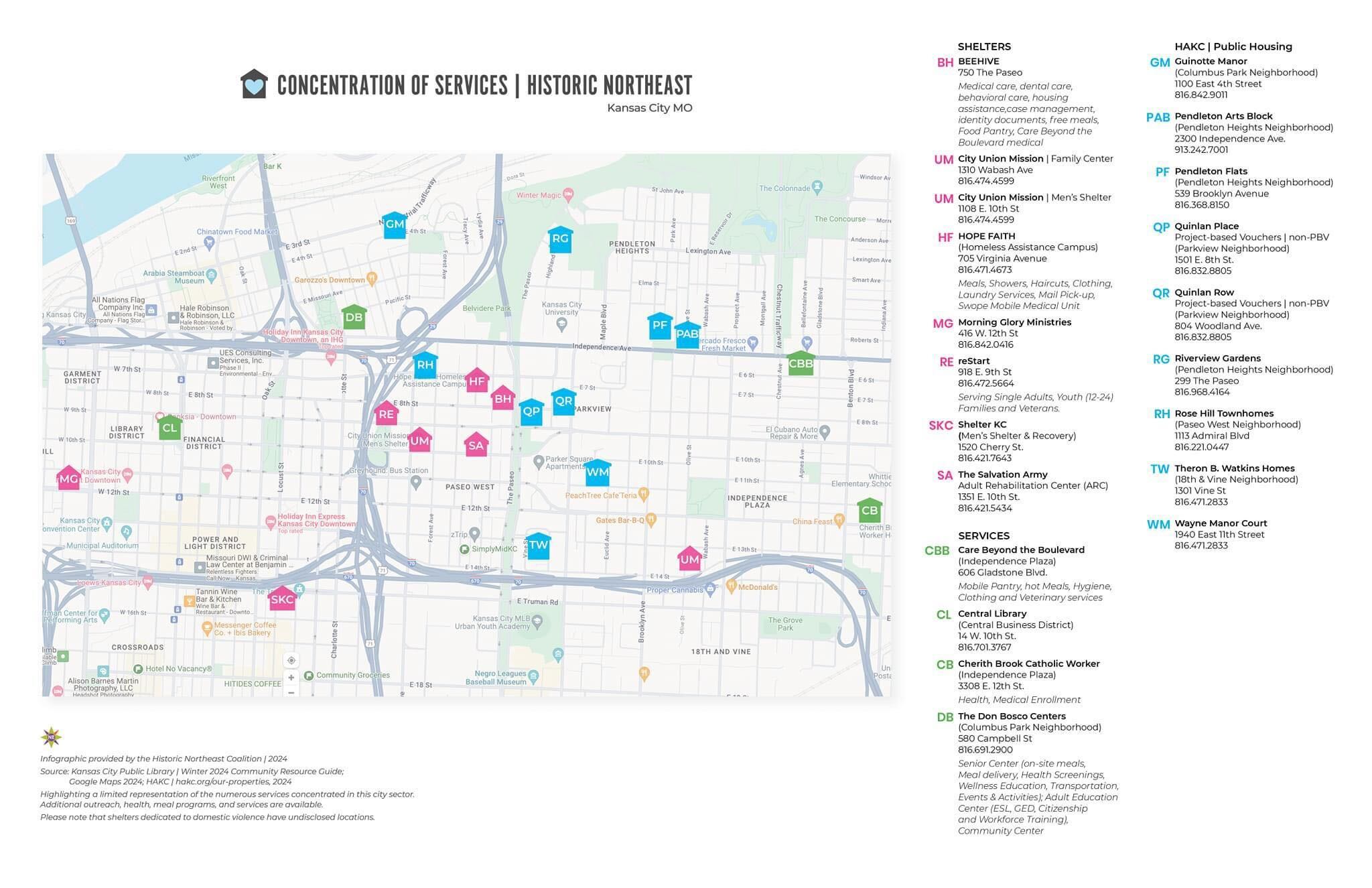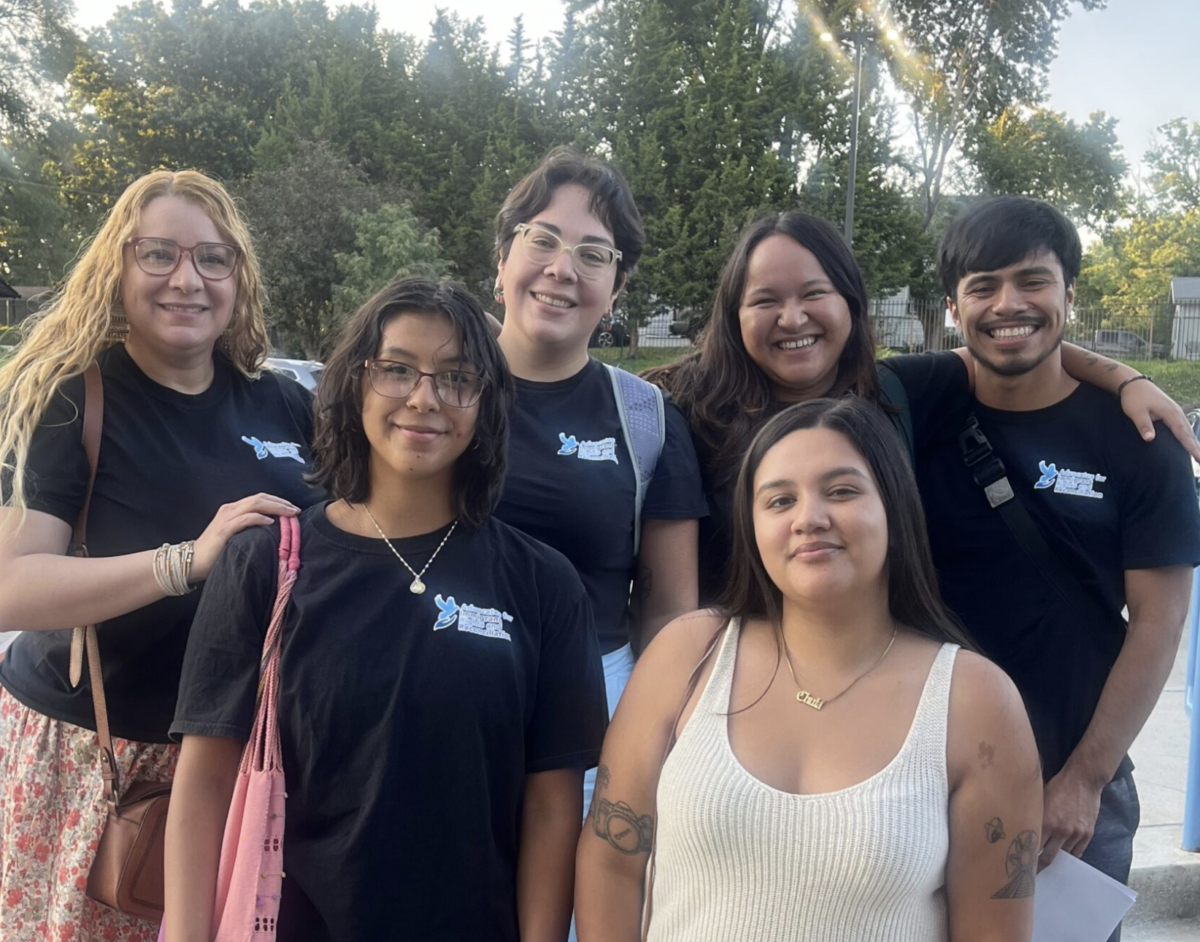
Abby Hoover
Contributor
The controversial ordinance to fund an 80-bed permanent low-barrier shelter at Hope Faith at 705 Virginia Ave. in Northeast Kansas City was held in Wednesday’s Finance, Governance and Public Safety Committee after dozens of public comments.
Ordinance 240046 authorizes the City Manager to negotiate and execute a $7,137,610 contract with Hope Faith-Homeless Assistance Campus to provide a non-congregate, low-barrier shelter facility to assist unsheltered families and individuals using previously-appropriated HOME ARP funds.
On December 7, 2023, the evaluation committee – which the Northeast Community Coalition has requested its members to be named for transparency – recommended the proposal of Hope Faith Ministries.
The ordinance was held for one week, although Committee Chairperson, Sixth District At-Large City Councilwoman Andrea Bough noted the committee may not meet this week due to the State of the City address.
In August 2021, the City Council directed the City Manager to create a strategic plan, Zero KC, to end homelessness. In 2022, the City began coordinating with the Greater Kansas City Coalition to End Homelessness (GKCCEH) and its partner agencies to coordinate low barrier shelter during extreme weather.
“Emergency shelter is part of Zero KC, which is Kansas City’s plan to end homelessness,” Assistant City Manager Melissa Kozakiewicz said in a presentation to the committee. “In 2022, we were able to serve 154 individuals and this year we’ve moved to 450. So we’re making great progress.”
On August 1, 2023, a request for proposals was released, beginning the public procurement process.
“This ordinance will provide emergency shelter beyond the winter months,” Kozakiewicz said. “The entirety of the funding comes from the American Rescue Plan (ARP). These funds need to be committed by December 31, 2024. These funds will not be used to build a new shelter. Funds will be used to renovate an existing shelter that has been serving individuals experiencing homelessness in this location for 10 years.”
Kozakiewicz said although there were multiple applicants, only one applied for the purpose of creating a low barrier emergency shelter. Hope Faith partnered with the City for the last two years to provide emergency shelter and services during the winter.
During the 2022-23 winter, the City, GKCCEH and partner agencies provided 154 beds nightly across five locations as part of the Zero KC plan to end homelessness. For 2023-24, they have expanded to offer 450 beds nightly across 10 locations.
These funds would allow for renovations to existing space. Hope Faith operates year round as a day center, and these funds would extend hours to 24/7.
“Once renovated, Hope Faith expects to offer a limited number of non-congregate bedrooms with bathrooms,” Kozakiewicz said. “Individuals will not be transported from other districts to this location.”
Third District Councilwoman Melissa Robinson hoped to provide the committee with the Third District’s perspective and updates on involvement in the process.
“Councilman [Crispin] Rea, a member of the committee, participated in a number of discussions along with Councilwoman [Lindsay] French. We’ve had several community meetings regarding the low-barrier shelter and the community does have some level of expectation around how we ensure that there’s some neighborhood cohesion,” Robinson said. “There has been a lot of discussion around how do we not put so many beds in one location. So instead of 80 beds – that was the original number that was brought to the community – that if we could provide some additional locations throughout the city that wouldn’t concentrate all of the beds in one area, that would be helpful and beneficial.”
Robinson added that the community hopes they can see some neighborhood mitigation dollars.
“This is a community in which they have a lot of blight and a lot of issues and the City needs to be investing and making sure that there’s vibrancy in the community,” Robinson said. “It is important that we had a taskforce to come up with the Vision Zero plan, and I would ask this committee to make sure that they get a chance to also weigh in. I know that we don’t have an established task force, but we don’t want to make these decisions in a vacuum,” Robinson continued.
Third District At-Large Councilwoman Melissa Patterson Hazley shared a map showing the concentration of services in Northeast Kansas City.
“The things that we have been trying to convey as the Third District leadership is that we would really like the City of Kansas City to move away from, sometimes inadvertent actions that do concentrate poverty,” Patterson Hazley said. “The Third District is, unfortunately, carrying a lot of the load in terms of taking care of our most vulnerable people, and we would like the other districts across Kansas City to have the opportunity to participate in providing help to our most vulnerable, not just this neighborhood alone.”
Patterson said there is an overabundance and overrepresentation of services in Northeast, and said while residents are not against any of these things, they hope for an equity in participation in providing services citywide.
Service providers from other parts of the city were in attendance and provided public testimony supporting smaller scale low-barrier shelters.
Robinson noted that HUD has conducted extensive research around the concentration of poverty and has made sure that there are vouchers in more affluent areas and how that supports economic mobility.
“It supports the stabilization of neighborhoods… and we want to make sure none of our houseless community ever has to sleep on the streets,” Robinson said. “We also want to make sure that there’s economic mobility and we want to make sure that it’s just not concentrated in one area because that cuts off opportunities for them to be able to access different parts of our city, which the study is really clear on how the importance of making sure that people have access to all parts of our city is critically important.”
Councilmembers from the Sixth District noted that they often fight for resources for the Community Assistance Council, which is the sole provider of these services in South Kansas City, and they would be interested in facilitating a space for low-barrier shelter in their district.
“From everything I’ve heard from the neighborhood folks who I’ve spoken to, they’re not taking a hard ‘no’ position on any shelter or any services – which I think is significant because as you can imagine, a conversation about locating any kind of services that are going to cater to homeless folks becomes controversial – and I think when you look at NIMBY-ism, it’s kind of a classic example of ‘everyone will agree we need services but nobody wants it in their neighborhood,’ but it’s important to note that that’s not the position as I’ve observed of the neighborhood folks,” Fourth District At-Large Councilman Crispin Rea said. “As we’ve gone through this, the position has been, ‘We believe the services are necessary. Our neighborhood has housed these services for a long time. We just don’t want an undue burden placed on the neighborhood by the concentration of services,” Rea stated.
Robinson noted that City staff has said that there aren’t funds to do a more integrated approach with four or five city-wise locations, so that’s why one location was chosen.
Public testimony was given by employees of Hope Faith and their guests in support of the ordinance.
“Lives have been lost on our streets day in and day out because the number one thing Zero KC says is that sleeping on the streets is dangerous,” said Doug Langner, Executive Director of Hope Faith. “Shelter works… Everyone is asking us, ‘Come March 1, what’s next?’”
The Council has the opportunity in the coming weeks to address the needs of some of the City’s most vulnerable population, Langner said. People have gotten rest and self corrected their own houselessness at Hope Faith, he continued.
“I don’t have to tell you – if we had the housing stock that we should have – shelter is not the first option. We don’t have it. We need shelter now,” Langner said. “I’ve heard a lot of engagement about spreading this out through the city, Hope Faith encourages that. This issue is deeply rooted in our economic and racial injustices of our nation and our city. Here today is a solution at hand.”
Marquaia Watson, Director of the Greater Kansas City Coalition to End Homelessness, said sustained inattention and ignoring of this problem will not end it, it will exacerbate it.
“We in this sector are seeing ourselves in a zero sum game, where every person we house, we see two more people coming into the space without housing or in severe housing instability,” Watson said. “We have got to move more swiftly on this issue.”
Nourish KC Executive Director Mandi Jean Retter noted that since Hope Faith opened its emergency shelter for the winter, no one has been sleeping outside their doors when there were previously 20 or 30.
“No one is standing here saying that low-barrier shelter services are not needed, and no one is standing here saying that Hope Faith doesn’t have the right to be one of the contractors,” said Evie Craig, President of the Paseo West Neighborhood Association. “What we’re saying is this is a unique opportunity to have a very innovative solution that isn’t solely one large shelter in one area, rather a much more nimble, open process that doesn’t put all the burden on one provider or one contract, but really puts the burden on the community of providers to say, ‘Let’s open low-barrier services up for all populations in all areas of Kansas City.”
Pendleton Heights resident Jonathan Coakley said he appreciates the Council’s expediency to utilize funds available to do something to help combat the problem of lack of available beds for the unhoused population and he would like to see the money allocated as efficiently as possible, to do the most good possible.
“I also recognize that the ordinance does not include all of the pieces that are really needed to create a healthy community,” Coakley said. ‘Things like money for infrastructure improvements, ordinances to help deal with absentee property owners that are holding on to property that often becomes the location for things like building fires and that could be further developed to create economic opportunity and additional housing supply in the neighborhood.”
Pendleton Heights resident Patrick McLaughlin, an elder in the United Methodist Church and CEO at SAVE Inc., an organization who has a low barrier LGBT shelter for youth ages 18 to 24, said they would be delighted to work with Hope Faith and the City to expand their capacity to address the concerns that were raised.
“As we know, that’s a growing need and we totally understand the concerns of living in a shelter as an LGBTQ person,” McLaughlin said. “I’m also somebody that’s experienced homelessness and somebody that has a mental illness. I know how dangerous it is to live on the street and believe that we have to do something to move forward on this topic. I would like to see, like many of my neighbors, this solution be spread throughout the city. I understand the economic constraints of that, and again, believe that we need to start somewhere.”
The surrounding neighborhoods of Northeast Kansas City have made recommendations to the City, shared here: northeastnews.net/pages/northeast-coalition-unveils-unified-demands-for-citys-low-barrier-shelter-proposal/.
For previous coverage of this ordinance, visit northeastnews.net/pages/message-sent/ and northeastnews.net/pages/potential-new-shelter-location-has-northeast-neighbors-on-edge/.


















